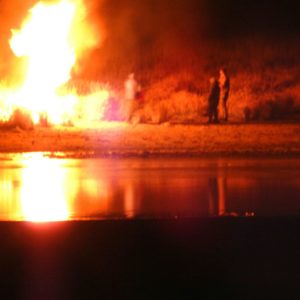For more than a year between 2016 and 2017, thousands of people crowded into three protests camps in North Dakota. Ostensibly, they were there to halt construction of the Dakota Access Pipeline. The reality was more complex, bringing together environmentalists, Native American activists, members of Black Lives Matter, and sympathetic citizens. Area residents saw it all up close: both the rituals and prayer, and the blocking of roads and violence against law enforcement. Today, the camp is gone, but the scars remain.
Many people, looking at the protests, focus on the cost to Energy Transfer Partners (ETP), the company building the pipeline. According to a study just released by the University of Colorado at Boulder, the protests cost ETP and other firms with ownership stakes in the project no less than $7.5 billion. The banks that financed the project lost an additional $4.4 billion through account closures.
But the true costs of the protest camps are more than dollars.
“It will take a generation to work past the effects of this,” says Julie R. Neidlinger, a writer and pilot from Bismarck, N.D. Neidlinger published a book, Blue Like a River, to give voice to the local perspectives that she believes were drowned out during the protests. “The narrative of white, racist North Dakota is something that keeps being brought up.”
She is open about how the protest harmed the relationship between Standing Rock and the communities of Bismarck and Mandan. Even finding the right words to describe the situation is difficult, since many tribal members live off of the reservation in these cities. Before the protests, the tribe was a neighbor. During the protests, many news stories depicted the area as two sides pitted against each other.
But no story is ever as simple as it first seems. Neidlinger collected dozens of interviews with local police officers, tribal members, and local residents, trying to add a local dimension to the story.
The view of the protests that most of America saw on television focused on the David and Goliath story of the plucky protesters standing up to the faceless corporation. This narrative leaves out the story of the broader community, which was caught up in the protests whether they wished to be or not.
“The way it was painted, that it was white racists against natives, was completely inaccurate,” Neidlinger told InsideSources, explaining that while the protests began as a dispute over access rights and a pipeline, other groups coopted the movement to push for a carbon-free energy future, changes in the relationship between tribal and Federal governments, and simple fundraising.
On the other side was not a faceless corporation, but a community. Local law enforcement resources were pushed to their limits attempting to maintain order around the camps. Meanwhile, the community rallied to support them, organizing donations of meals, batteries, hand warmers, and other supplies for the officers.
Sadly, that community strength never made the headlines, though. When protesters made a trip to the station to donate food as a goodwill gesture, pictures were plastered all over Facebook.
“We wanted to show support for our law enforcement when we certainly weren’t getting much from outside the state. We all had to come to come together and help,” she said, expressing frustration with the media narrative that focused more on dramatic pictures taken in the camps, rather than the quiet work of Girl Scout troops and community groups supporting police.
As they dragged on, the protests wore out the patience of many area residents, says Neidlinger. In her book, she describes her own conflicted reaction to the news that ETP had sued Greenpeace and other environmental organizations, seeking to recover damages from the protests. Generally ambivalent toward the energy industry, she found herself oddly pleased at the prospect that someone was pushing back on the protesters.
“I’m no fan of lawsuits, but that felt like the only thing that would even possibly address the things we were frustrated about here in the community,” she said. “You have to keep in mind, we saw all these protesters get their charges dropped, get a slap on the wrist. We saw people get rich and continue to get rich. We were seeing all this and our state was footing $34 million in costs.”
The ETP lawsuit is ongoing. But ETP has helped to reduce the impact on the state of North Dakota as the company donated $15 million to cover damages caused by the protesters.
“We are grateful for Dakota Access Pipeline’s recognition of the significant impacts this project had on our state, our citizens and the law enforcement officers and emergency services personnel who worked tirelessly to protect the life, health and safety of everyone involved,” Gov. Doug Burgum said.
Neidlinger hopes that her book will encourage people to consider how events in the news impact real people.
“It’s important that people think about the places where events take place, not just the events themselves,” she said. “When we see events on the news, we want to say ‘There’s a bad guy, there’s a good guy.’ [Instead,] we need to think about the community all this is happening in.”

